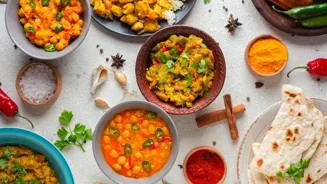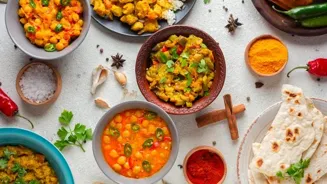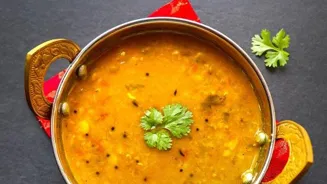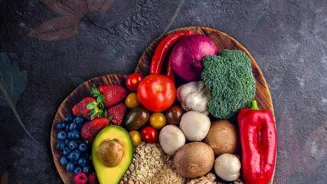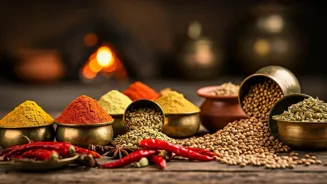Discover the art of mindful eating with Indian cuisine. Dive into the flavors and traditions of the Indian Thali
In today's fast-paced world, where chai breaks are often squeezed between deadlines and lunch
is scarfed down while scrolling through social media, it's easy to lose touch with the simple joy of eating.
We, as Indians, have a rich culinary heritage, a beautiful variety of flavors and traditions woven into every meal. But how often do we truly savor that warm bowl of dal, that crispy dosa, that perfectly spiced aloo gobi?
Mindfulness, the practice of paying attention to the present moment without judgment, offers a way to reconnect with our food and transform our eating habits from a mindless activity into a nourishing and fulfilling experience.
Let’s explore how to bring mindfulness to the Indian dining table and rediscover the pleasure of eating.
Practice mindful eating for a fulfilling food experience
Mindful eating is not about strict rules or restrictive diets. It's about cultivating awareness of your thoughts, feelings, and physical sensations related to food. It’s about making conscious choices about what, when, and how much you eat.

Think of it as a yoga for your taste buds, a meditation for your mealtimes. It's about slowing down and truly appreciating the food in front of you. Start by taking a few deep breaths before you begin eating. Notice the colors, textures, and aromas of the food. What spices can you identify?
What memories does the smell evoke? When you take your first bite, pay attention to the flavors as they unfold on your tongue. Notice the textures – is it crunchy, smooth, creamy? Chew slowly and deliberately, allowing yourself to fully experience each bite.
This heightened awareness can bring a new level of enjoyment to even the simplest of meals, turning your daily roti sabzi into a delightful and satisfying experience. The goal here is not to rush and relish every bite.
Practice mindful eating to distinguish physical hunger from emotional cravings
One of the most common challenges we face is eating when we're not actually hungry. We might eat out of boredom, stress, or habit. Mindful eating encourages us to pause and check in with our bodies before reaching for food. Ask yourself, "Am I truly hungry, or am I eating for another reason?
" Learning to distinguish between physical hunger and emotional cravings is a crucial step in developing a healthier relationship with food. If you're feeling stressed, try taking a few minutes to meditate or practice deep breathing before deciding to eat.
Engage in another activity like take a walk in garden, read a book. Sometimes, simply acknowledging your emotions and finding alternative ways to cope can prevent unnecessary eating. Avoid distractions while you are eating. It makes you less likely to over eat. You can start by turning off all devices
Mindful eating involves being present and savoring each bite
Mindful eating is not just about what you eat, but also about how you eat. In Indian culture, we often eat with our hands, a practice that can be incredibly mindful. The tactile experience of feeling the food can enhance our sensory awareness and slow us down.
Whether you use your hands or cutlery, be present with each bite. Avoid distractions like watching television or scrolling through your phone, as these can lead to mindless eating and overconsumption. Instead, focus on the food, the company you're with, and the conversation.
Creating a peaceful and pleasant eating environment can also contribute to a more mindful experience. Set the table nicely, light a candle, or put on some calming music. Make mealtimes a special occasion, a time to connect with yourself and your loved ones.
It helps to have a fixed time to eat everyday.
Explore diverse Indian cuisine mindfully for deep appreciation
Indian cuisine, with its diverse range of flavors and spices, offers a wonderful opportunity to practice mindful eating. Each region boasts its unique culinary traditions, from the fragrant biryanis of Hyderabad to the spicy curries of Kerala.
Take the time to explore the different flavors and textures of Indian food with a mindful approach. As you savor a spoonful of sambar, notice the subtle blend of spices and the tangy tamarind. When you bite into a vada pav, appreciate the crispy exterior and the soft, flavorful filling.
By consciously engaging with the rich tapestry of Indian cuisine, you can deepen your appreciation for the food and the culture it represents. Try to include fresh, whole foods in your diet.
These foods are naturally more satisfying and often require more chewing, which can further slow down your eating.
Practice portion control and listen to hunger cues for mindful eating
Portion control is another key aspect of mindful eating. We often tend to overload our plates, especially when faced with a delicious spread of Indian dishes. Mindful eating encourages us to be more aware of our hunger and fullness cues.
Start with a smaller portion than you think you need, and then pause after each bite to assess your hunger level. Are you still hungry, or are you starting to feel satisfied? Give your body time to digest and signal when it's full before reaching for more.
This can help prevent overeating and promote a healthier relationship with food. Avoid using very large plates for your meals as you will be more likely to fill them up and then eat more than you need to. You should also allow yourself to eat whatever it is that you are craving.
Don’t make food offlimits.
Mindful eating is a journey of cultivating new habits
Mindful eating is a journey, not a destination. It takes time and patience to cultivate new habits and break old ones. Don't get discouraged if you slip up occasionally. The important thing is to keep practicing and learning from your experiences.
Start with small steps, such as taking a few deep breaths before each meal or focusing on one bite at a time. Gradually, you can incorporate more mindful practices into your daily routine.
Remember, the goal is not perfection, but rather to create a more conscious and fulfilling relationship with food. And in the long run, this can lead to improved health, well-being, and a deeper appreciation for the simple joys of eating.
So, the next time you sit down for a meal, take a moment to pause, breathe, and truly savor the flavors of India.

